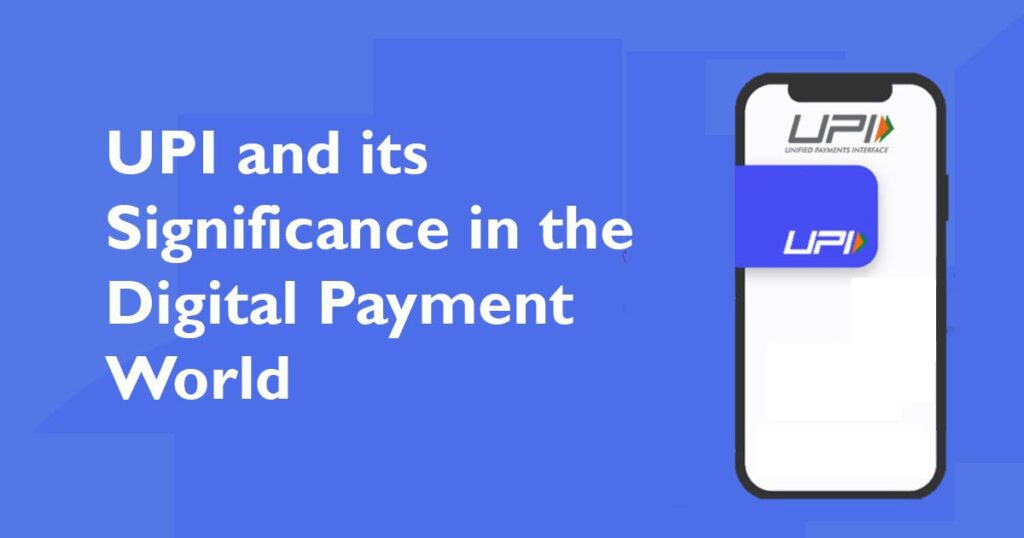A mobile device can be used to conduct real-time transactions between bank accounts using the Unified Payments Interface (UPI) payment system. The National Payments Corporation of India (NPCI), developed the instant digital payment system for running retail payment and settlement systems in India.

UPI has transformed payments in India quicker, less expensive, and more practical. Users can send and receive money By using their bank accounts, pay bills, recharge mobile phones, and pay for a variety of services.
UPI has gained widespread acceptance in India with more than 100 crore transactions worth more than Rs.2 lakh crore processed in April 2021 alone. Since its launch in 2016, UPI has seen rise in the volume of transactions, making it India’s most popular digital payment method.
UPI’s Significance in the Digital Payment World
Due to its many advantages over alternative payment methods, UPI is becoming more and more well-liked by users. Let’s examine some of the main benefits:
As UPI supports instant payments between bank accounts, the funds are credited to the beneficiary’s account in a seconds. For users who need immediate payment transfers, this feature has made UPI the go-to payment option.
Compared to other payment methods like debit and credit cards, UPI transactions have low transaction fees. As a result, UPI is now a user-friendly payment option.
Mobile phone users can easily transfer money using UPI thanks to its excellent user-friendliness. Users have the option to link their bank accounts to their mobile numbers, and UPI offers a safe and easy way to make payments.
user don’t need to carry cash to make payments. Their mobile phones make it simple for them to transfer money, making it a practical payment method.
UPI is a well-liked payment option in India because it is widely accepted by retailers, online stores, and service providers.
UPI has revolutionised the way people make payments in India by offering a simple and inexpensive payment system. With more users turning to it for their daily transactions, it has become the most popular form of digital payment.
UPI is now available to people from all demographic groups, including those who had never used a bank before. Additionally, UPI has made it possible for small businesses and retailers to accept digital payments, which has accelerated India’s financial inclusion and digitization.
Read More : UPI Full Form: Everything about UPI Payment
Evolution of UPI
India’s digital payment environment has been significantly shaped by UPI, which has become an example for other nations to follow. Its popularity, low transaction fees, and user-friendly interface have contributed to its success, making it advantageous for both users and merchants.
UPI has also been accelerated by the Indian government’s push for a cashless economy and digital transactions. To encourage the use of digital payment systems like UPI, the government has launched a number of initiatives, such as Digital India and Make in India. A decrease in corruption and black money transactions, which were previously made in cash, has also resulted from the implementation of UPI.
UPI has been crucial in encouraging financial inclusion in India. People who previously lacked access to banking services now have access to them. Users who use UPI can make transactions without a physical bank account by connecting their bank accounts to their mobile devices. For those living in rural areas who might not have access to banks or ATMs, this has been a game-changer.
Read More : Paytm Payment Bank IFSC | Paytm IFSC Code
For retailers and small businesses, UPI has also been a blessing. Small businesses and merchants were previously hesitant to accept digital payments because of the high transaction fees levied by payment gateways. UPI, on the other hand, has low transaction fees, making it an affordable payment option for small businesses and retailers.
In conclusion, UPI has transformed the digital payment landscape in India by providing a quicker, more cost-effective, and more useful payment system. Its success can be credited to its simplicity, usability, affordable transaction costs, and wide acceptance. UPI has increased financial inclusion, pushed for a cashless society, and decreased both corruption and the use of black money. Due to its success, other nations have looked to it as a model, and it will likely have a big impact on how digital payments are developed in the future.






